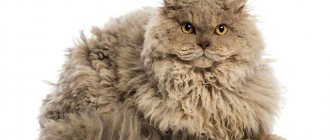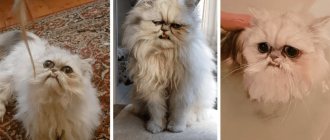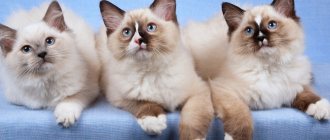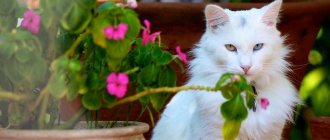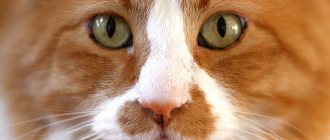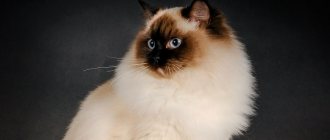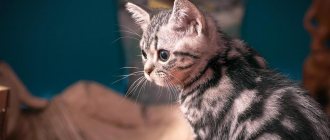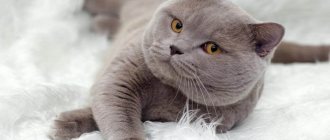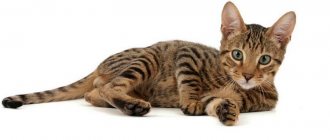Shaggy cats look much more impressive than their short-haired counterparts, and touching their luxurious coat evokes a lot of positive emotions in both adults and children. Therefore, many lovers of purring animals are not afraid of the prospect of collecting wool from clothes and upholstered furniture and acquire such pets.
Let's find out which breeds of fluffy cats are in greatest demand.
Persian cat
The fur length of Persian cats can reach 12 cm
Very long, thick hair and a flattened muzzle have become the hallmark of the Persian breed.
When long-haired cats first appeared in the East remains a mystery to felinologists. Their ancestors were probably African wild cats. The first documented ancestors of the Persians were imported from Iran to Italy and France in the 17th century. The breed further developed in Europe. In 1889 it received official recognition in Great Britain.
In addition to external characteristics, Persians attract people with their confident character, sociability and habits; they are people-oriented and cannot live outside their home, but at the same time they can be stubborn and willful. They love attention to their person, tolerate children and guests, but do not have any special affection for anyone other than the owner. Offenses are not forgiven.
Persian cats have been used in the development of many other long-haired breeds.
Popular breeds of chocolate cats with photos and names
There are not so many breeds of cats of true chocolate color. We have made a selection of breeds that, according to the standard, have a luxurious brown, cinnamon and chocolate coat.
Havana brown
Havana Brown is a rare breed of beautiful cats. The animals came to Great Britain from Siam in the 19th century. at the same time as Siamese cats. However, the British Siamese Cat Club has banned the breeding of other types of Siamese except blue-eyed Siamese cats. As a result, the Havana Brown population declined catastrophically, and the breed was on the verge of extinction.
Fortunately, in the 50s. XX century breeders began studying the genetics of cat colors and began conducting experiments as part of this program. The result of such research was the appearance of chocolate-colored muskies.
The Havana Brown's coat color has been compared to chestnut, hazelnut or mahogany. The breed received its name in honor of Havanese cigars, the color of which is similar to the color of these cats.
The coat color goes harmoniously with green eyes. The color of the iris varies from the lightest to the darkest shade. The Havana Brown's glossy, soft brown coat and emerald eyes make it a popular breed.
Another distinctive feature of the breed is its rounded, light-bulb-shaped muzzle. Depressions are visible in the area of the vibrissae. The chin looks heavy and massive. Large oval eyes set low. Large ears with rounded tips are tilted. Despite their compact size, the skeleton of these cats is massive, which is why males weigh 3.5-6 kg, females - 3-4 kg. Havana Browns give the impression of a sophisticated person, despite their well-developed muscles, and are distinguished by their gracefulness.
By nature, chocolate-colored Havana Brown cats are calm and balanced, affectionate and sociable. They need human attention and do not like to sit alone.
York chocolate
The Yorkie Chocolate cat was created by chance, the result of a mating between a farm cat with black and white spots and a long-haired black cat. Chocolate-colored kittens of the Yorkie cat breed with chocolate fur were born. Breeding was done by Janet Chifari from New York. Hence the name of the breed, which is popular only in its homeland. Felinologists admit that Persian and Siamese cats also participated in breeding.
The Yorkie beauty is distinguished by its large size, strong bones and developed muscles. The hind limbs are longer than the forelimbs. The semi-long coat frames the neck in the form of a “collar”. The structure of the coat is soft and silky. The coat is glossy and glistens in the sun. The undercoat is semi-long and dense. On the limbs and tail the hair is thicker and longer. Tufts of hair stick out between the toes, and the inner surface of the ears is pubescent.
Acceptable colors are chocolate and lilac solid, or with an admixture of white.
York chocolate is suitable for active people and families with children. Purr gets along with other cats, is distinguished by hunting skills, and loves to monitor the movements of people around the house. In addition, representatives of this breed love to swim. Owners of Yorkie beauties compare them to dogs. Animals are in constant motion, amenable to training, and love to play with interactive toys. Life with such a cat will not be boring!
Suffolk chocolate
The Suffolk Chocolate is a new breed that was introduced in 2014 and has already managed to win the hearts of cat lovers. The magnificent glossy fur will leave few people indifferent. In addition, representatives of this breed have an easy-going and sociable character.
The Suffolk Chocolate was bred by two Suffolk breeders from the Havana Brown. Hence the name of the breed. After enthusiasts began breeding Havana back in the 50s. XX century, several cats were sent to the USA, where the breed received its further development. This is how the American Havana Brown line was born.
The Havanas that remained in Britain had insufficient gene pool, so they were crossed with Siamese. This marked the beginning of the development of the modern Oriental cat.
Since 2007, Havana breeders began breeding cats from some British genealogical lines, and also included European cats in the program. As a result, they created the Suffolk Chocolate Cat, which received official recognition under the GCCF in 2014.
Suffolks have a smooth, glossy coat of chocolate and lilac colors. The body is medium size, graceful and muscular. The tail is long, slightly pointed, and the limbs are long and elegant. The ears are large and wide, the eyes are medium-sized and exclusively green.
The Suffolk Chocolate is a talkative and loving nature, prefers to be close to the owner and watch his work. Kittens never scratch, which means that the skin of your hands will be safe and sound. Physiologically, babies cannot release their claws and often fall from sofas and beds. Their affectionate and gentle nature makes these cats ideal companions for children. Like most eastern cats, Suffolk Chocolate cats are extremely intelligent and inquisitive. They always greet guests, love to sit on laps and play with toys.
The Suffolk Chocolate cat can also have a lilac tint. The eyes of these cats are medium-sized and always green.
Abyssinian
There is still debate about the origin of the Abyssinian cat, since it has not been possible to accurately determine the birthplace of the breed. The name comes from African Abyssinia, modern Ethiopia. According to one version, in 1868 Captain Barrett-Lenard took the ancestor of cats to England, where the formation of the breed began. In 1896, Abyssinian cats were first registered in the stud book of the National Cat Club.
Abyssinians are medium-sized animals with a developed muscular system. This breed has a special grace that no other cat has. The limbs are slender and long, the head is wedge-shaped, the ears are widely spaced. The eyes are expressive, large, almond-shaped, “rimmed” with black. The iris is amber or green. The coat is short, glossy, each hair is ticked and has two or three stripes of different colors. The color looks uneven, as if it shimmers. Recognized colors: wild, blue, sorrel, fawn, chocolate, cinnamon.
The wild appearance of the Abyssinian is deceptive; her character is very flexible. She is smart, affectionate, inquisitive and playful, loves to be close to her owner and has a hard time experiencing loneliness. Abyssinians are very active, but with proper training they do not damage furniture, do not gnaw flowers, do not rummage in the ground, and do not hang on curtains. Purrs get along well with other cats and dogs and get along well with children.
British Shorthair
The British Shorthair cat is a traditional English breed. According to one version, cats were brought to Foggy Albion by Roman legionnaires for more than 2000 years. According to another version, the plush cuties arrived on ships from France. In any case, the cats quickly adapted to local weather conditions and fell in love with the British. Until the 19th century “British” existed as domestic cats, then breeders took over them, who set a goal - to develop a separate breed.
Modern British cats are distinguished by their harmonious build, medium or large size, stocky limbs and massive rounded paws. The round head is crowned with wide-set ears. A muzzle with full cheeks makes cats look like koloboks. The eyes are large, round and wide open. The iris is orange, blue, blue, green, depending on the color. The coat is short, plush, dense, glossy, with a thick undercoat.
The most popular color is blue. However, the breed has 200 different colors: solid, tortoiseshell, tabby, color-point, bicolor.
The chocolate color was obtained after crossing “British” cats with chocolate Persian cats. This color looks especially advantageous in combination with an orange iris. Coat color varies, but the breed standard allows for any shade of chocolate color. Paw pads and nose skin are pink or chocolate.
Milk chocolate color is a rich reddish-brown color. These animals have pink or cinnamon paw pads and nose.
British cats have an easygoing disposition, are endowed with a developed sense of self-esteem and high intelligence. They are affectionate and good-natured, devoted to humans, love children, are friends with other cats and dogs, but will not tolerate familiarity. The “British” are not offended by their owners if they leave them alone for a long time. Cats, as a rule, are absolutely equally attached to all family members.
You will find more information about chocolate Britons in this article.
Oriental
The Oriental cat is elegant and graceful, a real “oriental beauty”. The name is translated from English as “eastern”. Orientals, a group of oriental cats, have the same standard as the Siamese breed, with the exception of eye color and coat.
Brown cats of the Oriental breed are flexible and graceful, slender and muscular, which reminds them of wild cats. Their fur is smooth and shiny, their limbs are long and slender. The eyes are expressive, almond-shaped, green or yellow, and the ears are large. Cats are trusting, sociable and open, inquisitive and brave, devoted to their owner.
Orientals are constantly on the move, amenable to training, happy to follow any commands, walk on a leash, and bring objects to the owner. Cats love to be hugged and petted. Lack of attention negatively affects their character - animals become too noisy and demanding.
Read about black and white orientals here.
Reference. The Havana color is an exotic color for Orientals, and a little unusual, since it is often found in native breeds.
Burmese shorthair
The ancestors of Burmese cats are the Siamese and the “copper cats” of Burma. The ancestor of modern Burmese was a little cat named Wong Mau. Her fur coat was dark brown. At first, Wong Mau was thought to be a chocolate-haired Siamese because such cats were common. They had brown skin and brown fur with black spots. Wong Mau became the progenitor of two breeds: Burmese and Tonkinese.
The first Burmese kitten arrived on the west coast of San Francisco in 1930. Dr. Joseph Thompson developed a breeding program for chocolate cats. Official recognition of the Burmese in 1936. Cats appeared in Europe in 1949, and in 1953 the breed was registered in the English GCCF system. The first standard assumed only a chocolate color, and in 1955 the color standard was expanded after the birth of a blue Burmese kitten.
The Burmese cat is of medium size, densely built, well-developed muscles, and smooth coat. The limbs are slender, the paws are neat with oval pads. The tail is straight, of medium length, tapering to the tip. The ears are large, set wide, tilted forward, and have rounded tips. The look is from under the brows, the eyes are set wide. Amber iris. The head is wedge-shaped, softly defined.
Cheekbones are pronounced and wide. The lower jaw and chin are well developed.
Burmese are energetic and temperamental cats, mischievous as kittens, even in adulthood. They are smart and quick-witted, attentive, delicate, feel the mood of the owner, and do not bother them with their games. Burmese quickly learn the rules of behavior and get along with children. When communicating with other pets, they take a leadership position.
Chantilly Tiffany
Little is known about the origins of the Chantilly Tiffany beauty. One thing is clear - Jenny Robinson began breeding it in 1967. The breeder purchased a pair of Thomas and Shirley, with chocolate coats. In 1969, they gave birth to chocolate-colored kittens with amber eyes.
In the early 70s. the offspring were registered as “Foreign longhaired cats.” The animals looked like Burmese, which confused the breeders.
Later, an American breeder from Florida decided to cross these cats with Burmese and gave the breed the name Tiffany. However, the animals were not related to the Burmese and were similar only in appearance. Tiffany's real ancestors were Siamese. During the research, it was possible to establish that Tiffany is related to Angoras, Abyssinians and Havana Browns. The offspring of the couple Thomas and Shirley almost disappeared, but in the 80s. Canadian breeders set about restoring this line. Since the breed name Tiffany already existed in the UK, the updated breed was named Chantilly Tiffany.
Chantilly Tiffany has a slender body, strong muscles, a short neck, and a triangular head with smooth contours. The ears are slightly tilted forward and the tips are rounded. The eyes are large oval. Amber iris. The tail is bushy, the same length as the body. The coat is semi-long. The hind limbs have “woolen skirts”. The most common color is chocolate. Black, purple and blue are also common.
Tiffany's character is a cross between the calm Persian cats and the energetic cats of the eastern group. Chantilly inherited its delicacy from the Siamese.
The animals are reserved and calm, not prone to too active games, loving and devoted to their owner, devoted to him. They are wary of strangers. Brown Tiffany cats do not like to sit alone, so they are recommended for families with children.
Himalayan cat
This breed was not named after its region of origin, but after the Himalayan rabbits due to their similar color and coat length.
Himalayan cats are the result of crossing Persian and Siamese cats. In the 20th century, many breeders tried to breed Siamese-colored Persians; in the 50s, the American Margarita Goforth succeeded in doing this.
Like Persians, Himalayan cats are calm, sociable, willful and intelligent, but a little more energetic. They love their owner's attention.
Content Features
When purchasing a nice fluffy kitten, you need to be aware in advance that you will have to take a lot of constant care for its fur. Accordingly, you will need to accustom your baby to regular combing from the, as they say, youngest claws. This approach will subsequently save both the animal and you from many problems.
Grooming
It is imperative to take care of your cat's fur, regardless of its length. But long and thick fluffy wool, of course, requires special attention. Most cats don’t like bathing too much, but you shouldn’t get upset because of this and try to force your pet into the shower, especially if she is clean by nature and is used to carefully licking her own coat.
It is enough to bathe the cat as the fur becomes dirty - when it becomes dusty, dirty or sticky. For local contamination, you can use various cleansing wipes; dry shampoos also help. The range of modern cat hair care products is very large, from which you can always choose something that is ideal for the specific characteristics of your pet’s hair. Do not experiment with human shampoos - they are not suitable for cats.
The sooner you teach your furry to be hygienic, the better.
Brushing for a fluffy cat is a very important procedure, much more important than bathing. In those places where softer fur grows - usually on the stomach, armpits, neck and groin - it often gets confused and can reach the sad state of felt, which becomes impossible to comb, all that remains is to cut it off.
Please note that this is not only an aesthetic problem - neglected furries suffer from skin diseases, itching, allergies, and eczema. They feel extremely uncomfortable, so they can refuse food, become depressed and even become seriously ill.
If you don’t comb the tangles in time, you can only get rid of them in a radical way.
In most cases, brushing a long-haired cat once or twice a week is enough, but there are breeds for which grooming should become a mandatory daily ritual. A groomer's mandatory home kit should consist of the following tools:
- fine metal comb;
- “rake” comb with rotating teeth;
- slicker;
- furminator.
If you cannot cope with caring for your pet’s coat on your own, regularly seek advice and practical help from professionals.
Photo gallery: fashionable haircuts and hairstyles for a fluffy cat
Most often, Persians are shaved radically - “like a lion”
The “Puss in Boots” haircut is one of the most popular
This is how you can make a dinosaur out of a cat
Glamorous hairstyle option - only for girls
This grooming is especially effective on thick red fur.
This hairstyle is suitable even for the most brutal macho man
Video: how to care for cat fur
Tendency to diseases
Fluffy cats get sick just like all others, but these breeds are more prone than any other to various skin diseases. Such ailments can be caused by an incorrect diet:
- poor quality or unbalanced menu;
Treats from the master's table are not food for your pet
- lack or, conversely, excess of vitamins;
- overfeeding and physical inactivity.
A timely visit to the veterinarian will help avoid many problems.
Do not neglect the advice of the breeder and veterinarian - they will help you optimize your pet’s nutrition and improve its metabolism. This will improve not only the condition of the animal’s coat, but also its overall health. But every owner is capable of taking care of his pet’s hygiene - initially make such procedures regular.
Reproduction
Breeding work is a very responsible process, and it should definitely be done by professionals.
Do not breed your pets “for health” - this is a thoughtless and incorrect approach to breeding animals, especially purebred ones. This is how a huge number of animals with bad heredity appear, and mixed breeds, which sooner or later may turn out to be of no use to anyone and end their lives in the trash heap.
For fluffy cat breeds, it is especially important, under the supervision of your breeder, to choose the right parent pair. The strategic goal of mating must necessarily be preservation in the offspring, and ideally, improvement in the quality and structure of the coat, as well as other breed qualities. Both producers must be completely healthy, vaccinated and promptly treated for parasites.
Entrust the choice of parent pair to an experienced breeder
Just before mating, do not forget to trim the hair around the genitals of the future parents short - this will make the process more hygienic and reduce the risk of injury to the animals.
Highland Straight and Highland Fold (Scottish Longhair cat)
Highland Straight and Highland Fold are long-haired varieties of the more famous Scottish Fold and Straight Shorthair cats.
To obtain more new colors, breeders included Persians, Exotics and Britons in Scottish cat breeding programs. With their blood came the recessive gene for long hair. At first, the fluffy kittens were discarded, but they were so beautiful that they could not stay away.
Thanks to the efforts of breeders and breed lovers, today most felinological organizations recognize the Scottish Longhair, allowing them to participate in exhibitions. Their character is no different from their short-haired counterparts. Highlands are gentle, kind and stress-resistant animals that do equally well in large families with children and with single people.
Buying a kitten
There is probably no more charming creature in the world than a small fluffy kitten - a gentle and touching bundle of soft, warm fur. However, all children tend to grow up quite quickly, and problems that at first might seem completely insignificant to you grow with them. A few tips to help you make the right choice:
- Do not be led by your emotions - do not buy a kitten spontaneously, succumbing to a completely understandable feeling of tenderness at the wonderful baby - you are not buying a soft toy, but a living creature that has its own character and its own needs.
The little fluffy ball will grow up soon, so it’s important to base your choice of a kitten on more than just cuteness
- You will need to take care of the kitten, educate, adapt, tolerate its pranks - it is quite possible that some problems associated with the new family member will not suit your family - be sure to consult with them and make only a collective decision.
- Try to learn as much as possible about the breed you like, prepare for the arrival of a kitten in your home, both theoretically and practically - purchase in advance everything you need for feeding, rest, hygiene and leisure for your baby.
How to choose
You need to decide in a timely manner not only about the breed, but also about the purpose of acquisition. Do you want a boy or a girl? Pet or show-class animal? The criteria for choosing a little furry will largely depend on your ambitions and financial capabilities.
But the main selection criterion always remains the same - you need to purchase a healthy animal with good heredity. It is clear that no one can give one hundred percent guarantees on these issues in advance, but buying a baby not on the market, but in a professional breeding nursery, still significantly reduces many risks. In addition, a responsible breeder will forever remain your friend and first mate.
Don't try to buy a kitten that is too small; The optimal age for moving him to a new home is 2.5–3 months, when the necessary vaccinations have already been completed and independent living skills have been acquired. If possible, look at the conditions in which your baby grew up, observe the habits and habits of his parents, brothers and sisters.
After two months, vaccinated kittens can move to a new place
The baby will get used to the new place quite quickly, and from the second or third day he will need to be taught the rules of life that you consider necessary. The sooner he learns them, the more positive and pleasant moments will appear in your life together.
Find mutual understanding with your baby as soon as possible
Video: fluffy kittens - all good
Cymric (Welsh cat)
For a long time, felinological associations did not want to recognize the tailless long-haired cat. Until now, many people call it just a variety of Manx
Manx is a breed of tailless cat that developed naturally on the Isle of Man, located near Ireland. They participated in exhibitions back in the 19th century. By the beginning of the twentieth century, the breed was already recognized in Europe and the USA. Among the short-haired Manx there were sometimes cats with long hair; Canadian breeders paid attention to them in 1976 and achieved official recognition, but under a different name - the Cymric cat.
The ancestors of the Cymrics were famous as excellent mousecatchers. The cats have not lost these skills. They are territorial and independent, not lacking in intelligence and can be aggressive if necessary. With close people they are calm and affectionate, moderately playful and curious.
Kymrik did not gain the popularity he deserved. One of the reasons lies in the difficulty of breeding. When crossing two tailless cats, there cannot be offspring, and when mating tailless and tailed cats, kittens are not always born that meet all breed standards.
Recognized breeds of fluffy cats
Any mestizo or subspecies bred in a couple of years cannot be considered a separate independent breed. As a rule, officially recognized varieties are certified in one of the leading felinological communities.
Cats have a pedigree, metrics and documentary evidence of origin. Its exterior must comply with established standards, which, in turn, is also documented. Only a complete package of certified papers gives the right to further breed selection and participation in exhibitions as a representative of a kind.
At first glance, it seems that the number of special species of domestic cats has exceeded 700. However, leading international associations of cat breeders recognize only a few dozen.
The World Cat Federation FIFe only approves 42 breeds.
The European WCF recognizes 70.
The CFA of America limits the number to just 40 official breeds.
Work on the development and standardization of new species is ongoing. It is possible that some resistant phenotypes will soon receive official status. In the meantime, when buying a kitten, you should pay attention to the documents and the breeder’s affiliation with an official organization. Of course, if it is the status of the breed that is important.
Most people consider fur color and special appearance features, such as a flat muzzle, drooping small ears or short legs, to be a much more important criterion when choosing a pet.
A review of officially recognized furry cat breeds will not be too long. Today, these are the oldest in origin, known for decades and having such characteristic species features that it is almost impossible to confuse them with anyone else.
If you are a furry lover, then be sure to read our article about the most beautiful cats in the world, you will appreciate it.
Selkirk Rex
Interestingly, the quality of the curl of the Selkirk Rex is influenced by the season, heredity and age, so each representative of the breed is unique
This is one of the most unusual long-haired cat breeds. The history of the Selkirk began in America in 1987, when a pregnant domestic cat was brought to a small shelter. Soon she gave birth to 6 kittens, one baby had very beautiful green eyes and curly hair. He became the founder of a new breed.
By nature, Selkirk Rexes are calm, patient, affectionate and silent, they are playful and intelligent, they sense the mood of their owner well and do not tolerate loneliness well.
Recommendations for choosing a fluffy kitten
How to tell if the kitten in front of you is fluffy? Fluffy cat breeds are noticeable due to several characteristics:
- From a young age they look cute, like a voluminous ball of fur. By the way, they have it wavy and raised.
- The ears and tail are also covered in fur. The more, the softer the adult will be.
- If possible, take a look at his parents. Their breed must be from an internationally verified list or they both appear to be fluffy in appearance.
How to determine if a kitten is fluffy?
Even with all the disadvantages of care, such breeds will always be in demand. Soft and fluffy four-legged animals create an atmosphere of goodness in the house!
Siberian cat
The long hair of Siberian cats is considered relatively hypoallergenic
The Siberian cat is the pride of Russian felinology. This is a distinctive breed that was formed under the influence of environmental conditions. Such cats were first mentioned in the chronicles of the Trans-Ural region of the 16th century. Then they were called Bukhara. They probably appeared as a result of mixing the blood of ordinary domestic and wild cats.
By nature, Siberian cats are bold and courageous, act decisively, love freedom, walks and hunting. Not the best option for living in an apartment.
Kurilian Bobtail (15)
The Kurilian Bobtail is the fruit of love between Siberian cats and Japanese Bobtails, which fate brought together on the territory of the Kuril Islands. The fluffy cat with a tail and a belly button like a hare has independently developed and reproduced since the 17th century, but received a standard only in 2012, when TICA surrendered under the pressure of felinologists.
Sexual dimorphism is inherited from Siberians: cats up to 4.5 kilograms, males up to 7.5 kilograms. The body is squat, but with a strong muscular frame, allowing the breed to jump very high. The gradation of the tail within the breed is interesting - the longer the coat, the larger the tail can be. Long-haired representatives of the breed have a tail that can be up to 13 centimeters.
By its nature, the cat can even be called a watchdog - it is ready to protect its family in all seriousness, hissing and rushing at uninvited guests. And in games, a bob-tailed fluffy cat is like a dog - playing with a ball is the best entertainment for it.
Norwegian forest
The Norwegian Forest Cat is a national treasure of the northern country.
Until 1938, the Norwegian Forest Cat was not mentioned in any official source, although its ancestors are believed to have appeared in Viking times.
Despite the name, the forest cat is not obstinate at all, like a wild animal; it is affectionate, devoted, affectionate, sociable, very quiet and obedient. The only thing that remained in her from the forest was her love of hunting... butterflies.
Turkish Van(8)
Despite the name, the homeland of these fluffy white cats with markings on the tops of their heads is Armenia, and specifically Lake Van. It is precisely because of their long-term residence next to an open, calm body of water that modern representatives of the breed are very fond of water treatments and fish, to which other cats, let’s be honest, are indifferent.
Now the breed is considered an official national treasure of Turkey, but only individuals with different eyes are valued.
A show van is only considered if it has ring markings on its tail and no undercoat. The breed's fluffy coat holds volume due to its lightness, rather than the supporting down of the underside. Also, the cat should not be completely white - this is a critical violation for the admission of an individual to exhibitions.
Ragdoll
Interestingly, all Ragdoll kittens are born white, their color begins to appear only at the age of 8-10 weeks, and full color is formed by 3-4 years
Translated from English, the name of the breed means “rag doll.” And indeed, these cats are a model of relaxation. They are always relaxed and do not show aggression, obedient and calm. This amazing submissiveness has led to the myth that Ragdolls are resistant to pain or unable to support their paws. This is wrong.
Ragdolls were bred in the United States in the early 60s of the 20th century by Persian cat breeder from California Ann Baker. Her goal would be to produce a breed that would have a gentle disposition and could completely relax in the hands of a person. The founders were selected primarily by character. According to the author's idea, the breed was to be called Cherub.
Ragamuffin
Translated from English, the name means “ragamuffin”. This breed was obtained by crossing Ragdolls with Persians, Himalayans and mongrel cats.
The Ragamuffin is a relatively young breed that was first presented at an exhibition in the mid-90s. Received official recognition in 2003. The origins of the breed were the same breeder who created the Ragdoll.
Ragamuffins are calm, playful, affectionate and smart cats that easily adapt to any living conditions, love to sit in arms, and do not resist human actions. They do not welcome yard life, they are very trusting and harmless. Older Ragamuffins may darken their color with age.
American Bobtail(20)
The American Bobtail differs from its Japanese and Kuril counterparts in that it was bred from one random mutation of an outbred cat and crossing it with a Siamese breed. At the same time, it is possible that lynx blood flows in the genes, because there are characteristic tufts of fur at the tips of the ears. Now the breed is widespread only in the USA and has a standard only in associations of this country.
Owners of bob-tailed fluffy cats note that, despite its wild appearance, the breed is very docile, amenable to training and is well accustomed to walking on a harness. The bobtail will always take part in family affairs, and the cat loves to play with balls and mice.
Nibelung
The only difference between the Nibelung and the Russian Blue is the length of the coat.
Gray-blue Nibelungs with long silky fur look incredibly beautiful. Their name means "children of the mist" in Scandinavian. By the age of one year, a green ring around the pupil becomes noticeable.
Nibelungs have a calm, pleasant disposition. These are kind, gentle cats that do not like change and become strongly attached to one person.
Neva Masquerade
Neva masquerade cats began to be bred in St. Petersburg under the leadership of breeder Olga Mironova.
This cat breed was bred in the city on the Neva and is a variety of Siberian, from which it differs in its beautiful color-point (Siamese) color. Neva masquerade cats often have blue eyes. They got their name because of the darkening on their muzzle, reminiscent of a mask.
The Neva Masquerade is valued not only for its beauty. She has a calm character and a healthy psyche. The cat is discreet, fearless, patient. She has a developed sense of self-esteem, loves attention, but is rarely intrusive.
Sacred Burma
The cat breed of harmonious build, with a stylish color-point color and a catchy, even solemn name, is one of the very few recognized by absolutely all felinological systems. As you might guess, thanks to the uniqueness and beauty of its appearance. The calling card of the breed are neat snow-white “shoes”, as if worn on dark stockings. Burmese have a poorly developed undercoat, but a rather fluffy “collar” and tail. Bright blue eyes complete the look.
The history of the Burmese began in the 20s of the last century, but reliable information about the ancestors of the breed has not been preserved. The legend about the origin of the Burmese from amazing cats that allegedly lived in a Buddhist monastery in Burma is very touching, but implausible. However, the beautiful name stuck and even contributed to the popularity of the breed.
Highlander
The British Longhair is a variety of shorthaired cats, which is recognized by some associations as an independent breed.
More recently, the British Longhair has been recognized as a separate breed called the Highlander. They are valued for their calm, affectionate disposition and, of course, appearance.
As befits a Briton, the Highlander is quite capricious, but this is by no means a minus. It is the bright personality that attracts many to this breed.
Minuet (obsolete Napoleon-minuet)
These cats have nothing in common with cake, commander or cognac. To dispel all doubts, the title was shortened to "minuet", but the old version is still quite common
The author of the breed is John Smith, an American breeder who began working on his own breeding program in 1995. He crossed munchkins with Persians. The main distinguishing features of the breed are short legs and long hair, but, like munchkins, minuettes are often born with legs of a standard length.
Minuets are exclusively domestic; they do not need free range. By nature they are calm, affectionate, sweet, playful and curious.
Breeds recognized only by the CFA
Basically, this organization recognizes the same species of furry felines as the above organizations.
The exceptions are:
- The American Bobtail is similar to other varieties of short-tailed cats both in appearance and in character, but differs in the shape of its head and the tufts on its rounded ears.
- Ojos azules, with soft cream-colored fur and sky blue eyes.
- The Pixie Bob looks like a fluffy munchkin, so other associations do not distinguish it as a separate breed. A distinctive feature of such cats is not only short legs, but also tufts on their ears.
Bohemian Rex
In fact, the Bohemian Rex is also a Persian cat, but with curly hair
Another name for the breed is the Czech curly cat. It is considered relatively young and is so far recognized by only a few associations as experimental.
The “Bohemian” story began in the 80s in the Czech Republic. The curly-haired kittens that sometimes appeared in litters of Persian cats became of interest to breeders and they decided to consolidate the original trait. The Persians probably inherited the curly hair gene from Hermann rex.
The breed has not become widespread and remains very small even in the Czech Republic.
The fluffiest cat in the world
A cat named Colonel Meow was included in the Guinness Book of Records in 2013 as the fluffiest cat in the world.
The length of his fur was almost 23 cm. Colonel Meow became an Internet star thanks to his shaggy fur coat and gloomy expression on his face. This unusual kitten was created by crossing representatives of the Persian and Himalayan breeds. The record holder died of heart disease in 2014.
Burmese cat
One of the most beautiful and mysterious breeds
According to legend, the Burmese cat appeared in a Buddhist Temple, where the blue-eyed goddess Tsun-Xuanxa was worshiped. The monks believed that their pets helped in the transmigration of souls. At the beginning of the 20th century, a pair of cats stolen from a monastery ended up in France. The new breed won the hearts of cat lovers and was soon officially recognized.
A distinctive feature of Burmese cats is the color of their long, soft coat. It is uniformly light on the body, contrasting with the dark markings on the face, legs and tail. White socks are required on the paws. By nature, Burmese are calm and affectionate.
Angora cat
Until 1978, only white longhaired cats had the right to be called Angora. Today, the number of acceptable colors has increased, and there are fewer and fewer completely white Angoras.
Turkish Angora cats have been recognized as an independent breed in Europe since the beginning of the 18th century. But since then it has not been possible to keep the breed pure. In 1917, the Turkish government, together with the Ankara Zoo, began a program to save the national treasure - the all-white, odd-eyed Turkish Angoras. It is still in effect today.
Angora cats are active, inquisitive, and intelligent. They always try to be the center of attention and do not tolerate loneliness.
Laperm
Laperms can be short-haired or long-haired. Their fur is airy and elastic and looks disheveled.
Another unusual breed with long curly hair. Its name comes from the English permanent - perm. The first laperm from an ordinary domestic cat appeared. He was born completely naked and the owner doubted that the baby would survive. At the age of 6 weeks, his body was covered with short, curly hair. Growing up, he only became more beautiful and in the future became the founder of a new breed. A single standard for laperms was recognized in 1997.
Laperms are very friendly and loving. They try to be close, make friends with everyone, including dogs, and have a very difficult time withstanding loneliness.
